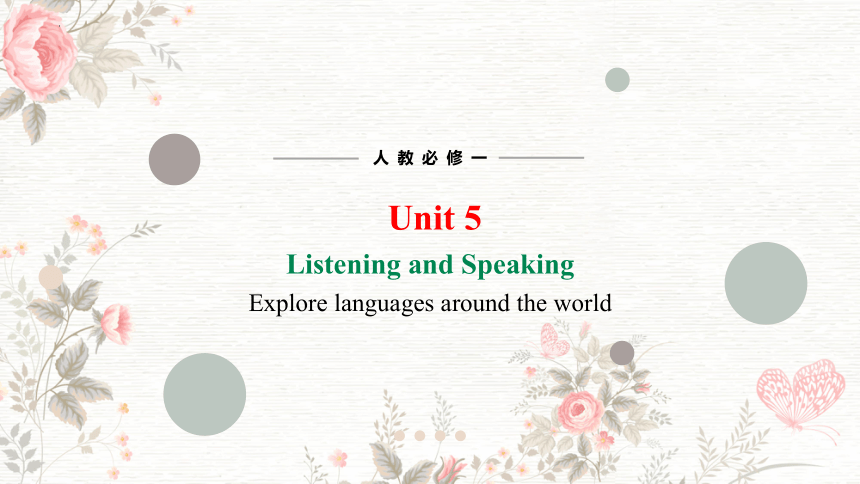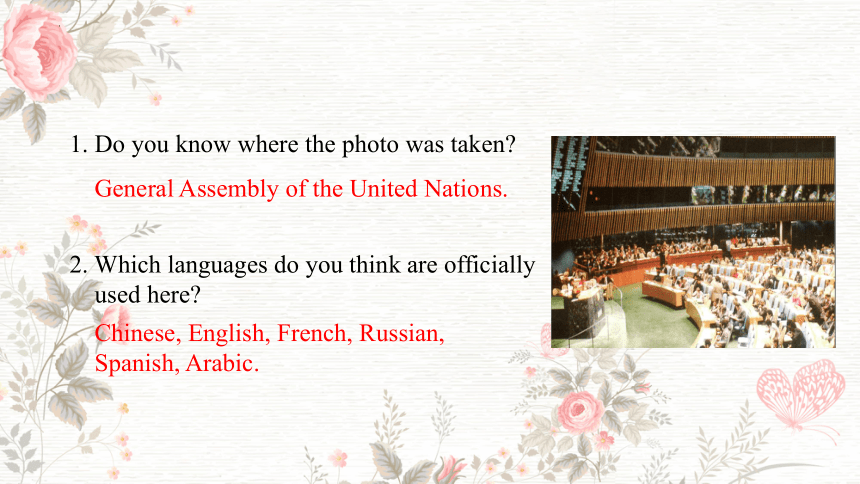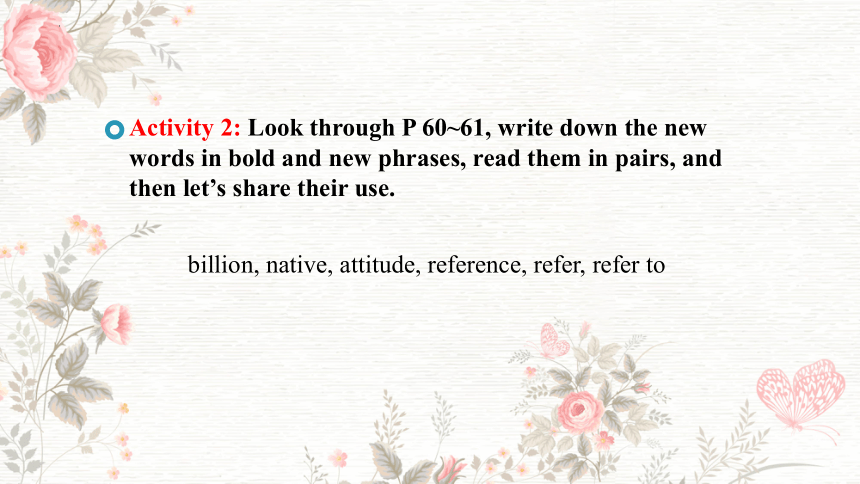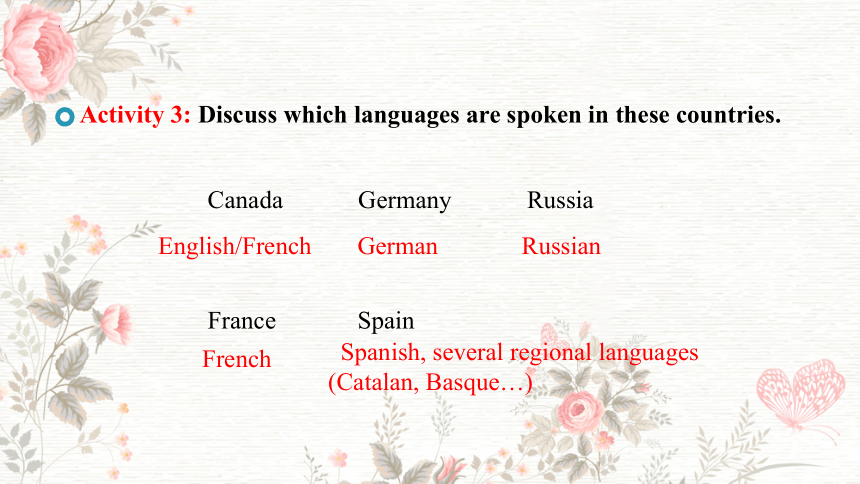人教版(2019)必修第一册Unit 5 Languages Around the World Listening and Speaking 课件(共19张PPT,内嵌音频)
文档属性
| 名称 | 人教版(2019)必修第一册Unit 5 Languages Around the World Listening and Speaking 课件(共19张PPT,内嵌音频) |  | |
| 格式 | pptx | ||
| 文件大小 | 16.2MB | ||
| 资源类型 | 教案 | ||
| 版本资源 | 人教版(2019) | ||
| 科目 | 英语 | ||
| 更新时间 | 2023-11-29 23:07:35 | ||
图片预览







文档简介
(共19张PPT)
人教必修一
Unit 5
Listening and Speaking
Explore languages around the world
教学目
Lead-in
One language sets you in a corridor for life. Two languages open every door along the way.
——Frank Smith
What do you think of this saying
Frank Smith
contemporary psycholinguist
(心理语言学家)
e.g.
Language is an effective tool for us.
1. Do you know where the photo was taken
2. Which languages do you think are officially
used here
General Assembly of the United Nations.
Chinese, English, French, Russian, Spanish, Arabic.
1
2
To know the world languages and the official languages of the United Nations by looking and listening.
To understand the pronouns and their reference in the listening text.
To talk about what language you want to learn and why.
3
目标一: To know the world languages and the official languages
of the United Nations by looking and listening
Activity 1: Match pictures with the correct country name.
France ________
Russia ________
Germany ______
Spain ________
Canada _______
India _________
CN TV tower
Red Square
Taj Mahal
Brandenburg Gate
The Louvre
Palacio Real
5
1
4
3
6
2
Activity 2: Look through P 60~61, write down the new words in bold and new phrases, read them in pairs, and then let’s share their use.
billion, native, attitude, reference, refer, refer to
Activity 3: Discuss which languages are spoken in these countries.
Canada Germany Russia
France Spain
English/French
German
Russian
French
Spanish, several regional languages
(Catalan, Basque…)
Activity 4: Brainstorming
Think about the following questions.
1.Why do you learn foreign languages
2.What's the biggest challenge when you learn foreign languages
1.For traveling, passing exams, studying abroad…
2.Pronunciation, cultural differences, lack of interests…
Activity 5: Listen to a speech and tick the two languages with the most native speakers. Circle the official languages of the United Nations(UN).
Russian
Chinese
Korean
Japanese
Spanish
Arabic
English
French
Activity 6: Listen to the speech again and answer the questions.
1.What is the main topic of this speech
2.How many languages are there in the world
3.How many billion people speak the UN’s official languages as their
native or second language
4.What is the attitude of the speaker towards foreign language learning
1.Learning a foreign language.
2.Nearly 7,000.
3.About 2.8 billion.
4.It is very useful to learn one or more foreign languages.
目标二: To understand the pronouns and their reference in the listening text
Activity: Listen to the speech again.
What do the italicized words refer to in the sentences
1.They think it means better job chances in the future.
2.They are spoken by around 2.8 billion people…
Reference: Pronouns(it, they, she, etc.) refer to something or somebody mentioned earlier.
Pay attention to the context of words to help you understand what the pronouns refer to.
Answers:
1.They: students who choose to study a UN language
It: studying a UN language
2.They: Six official languages:
Arabic; Chinese; English; French; Russian; Spanish.
目标三: To talk about what language you want to learn and why.
Activity: Work in pairs or groups. Discuss which other languages you want to learn and why.
EXAMPLE:
A: What language do you want to study
B: I really want to study French. I think that the French language sounds beautiful.
A: Why Do you want to go to France some day
B: Yes, I’d love to. Also, French is used by many
international organisations around the world.
Do you know that FIFA’s full name is in French
A: Oh, I remember that. But I don’t know how to pronounce it.
教学目
Pronunciation
Activity 1: Think and discuss
How much do you know about American English and British English
Can you tell some differences between them
There are some differences in spelling and pronunciation
between American English and British English.
Activity 2: Work in pairs. Read the words to each other and see if you pronounce them differently.
schedule
direct
hostile
laboratory
either
advertisement
address
shone
Activity 3: Listen and pay attention to how the speakers pronounce them.
schedule
direct
hostile
laboratory
either
advertisement
英 [ edju l]
美 [ sked u l]
英 [l b r tri]
美 [ l br t ri]
英 [ a (r)]
美 [ a r]
英 [ h sta l]
美 [ hɑ stl]
英 [d rekt]
美 [d rekt]
英 [ d v t sm nt]
美 [ dv r ta zm nt]
address
shone
英 [ dres]
美 [ dres]
英 [ n]
美 [ o n]
Activity 4: Listen to the paragraph read by two different speakers.
Which speaker has a British accent and which has an American accent
English is a crazy language. There is no egg in eggplant nor ham in hamburger; neither apple nor pine in pineapple. English muffins weren’t invented in England or French fries in France. Sweetmeats are candies while sweetbreads, which aren’t sweet, are meat.
…We find that quicksand can work slowly, boxing rings are square, and a guinea pig is neither from Guinea nor is it a pig. And why is it that writers write but… hammers don’t ham (Richard Lederer)
The first speaker
The second speaker
British accent
American accent
1.How many official languages are there in UN What are they
2.Do you want to learn a second foreign language Why
人教必修一
Unit 5
Listening and Speaking
Explore languages around the world
教学目
Lead-in
One language sets you in a corridor for life. Two languages open every door along the way.
——Frank Smith
What do you think of this saying
Frank Smith
contemporary psycholinguist
(心理语言学家)
e.g.
Language is an effective tool for us.
1. Do you know where the photo was taken
2. Which languages do you think are officially
used here
General Assembly of the United Nations.
Chinese, English, French, Russian, Spanish, Arabic.
1
2
To know the world languages and the official languages of the United Nations by looking and listening.
To understand the pronouns and their reference in the listening text.
To talk about what language you want to learn and why.
3
目标一: To know the world languages and the official languages
of the United Nations by looking and listening
Activity 1: Match pictures with the correct country name.
France ________
Russia ________
Germany ______
Spain ________
Canada _______
India _________
CN TV tower
Red Square
Taj Mahal
Brandenburg Gate
The Louvre
Palacio Real
5
1
4
3
6
2
Activity 2: Look through P 60~61, write down the new words in bold and new phrases, read them in pairs, and then let’s share their use.
billion, native, attitude, reference, refer, refer to
Activity 3: Discuss which languages are spoken in these countries.
Canada Germany Russia
France Spain
English/French
German
Russian
French
Spanish, several regional languages
(Catalan, Basque…)
Activity 4: Brainstorming
Think about the following questions.
1.Why do you learn foreign languages
2.What's the biggest challenge when you learn foreign languages
1.For traveling, passing exams, studying abroad…
2.Pronunciation, cultural differences, lack of interests…
Activity 5: Listen to a speech and tick the two languages with the most native speakers. Circle the official languages of the United Nations(UN).
Russian
Chinese
Korean
Japanese
Spanish
Arabic
English
French
Activity 6: Listen to the speech again and answer the questions.
1.What is the main topic of this speech
2.How many languages are there in the world
3.How many billion people speak the UN’s official languages as their
native or second language
4.What is the attitude of the speaker towards foreign language learning
1.Learning a foreign language.
2.Nearly 7,000.
3.About 2.8 billion.
4.It is very useful to learn one or more foreign languages.
目标二: To understand the pronouns and their reference in the listening text
Activity: Listen to the speech again.
What do the italicized words refer to in the sentences
1.They think it means better job chances in the future.
2.They are spoken by around 2.8 billion people…
Reference: Pronouns(it, they, she, etc.) refer to something or somebody mentioned earlier.
Pay attention to the context of words to help you understand what the pronouns refer to.
Answers:
1.They: students who choose to study a UN language
It: studying a UN language
2.They: Six official languages:
Arabic; Chinese; English; French; Russian; Spanish.
目标三: To talk about what language you want to learn and why.
Activity: Work in pairs or groups. Discuss which other languages you want to learn and why.
EXAMPLE:
A: What language do you want to study
B: I really want to study French. I think that the French language sounds beautiful.
A: Why Do you want to go to France some day
B: Yes, I’d love to. Also, French is used by many
international organisations around the world.
Do you know that FIFA’s full name is in French
A: Oh, I remember that. But I don’t know how to pronounce it.
教学目
Pronunciation
Activity 1: Think and discuss
How much do you know about American English and British English
Can you tell some differences between them
There are some differences in spelling and pronunciation
between American English and British English.
Activity 2: Work in pairs. Read the words to each other and see if you pronounce them differently.
schedule
direct
hostile
laboratory
either
advertisement
address
shone
Activity 3: Listen and pay attention to how the speakers pronounce them.
schedule
direct
hostile
laboratory
either
advertisement
英 [ edju l]
美 [ sked u l]
英 [l b r tri]
美 [ l br t ri]
英 [ a (r)]
美 [ a r]
英 [ h sta l]
美 [ hɑ stl]
英 [d rekt]
美 [d rekt]
英 [ d v t sm nt]
美 [ dv r ta zm nt]
address
shone
英 [ dres]
美 [ dres]
英 [ n]
美 [ o n]
Activity 4: Listen to the paragraph read by two different speakers.
Which speaker has a British accent and which has an American accent
English is a crazy language. There is no egg in eggplant nor ham in hamburger; neither apple nor pine in pineapple. English muffins weren’t invented in England or French fries in France. Sweetmeats are candies while sweetbreads, which aren’t sweet, are meat.
…We find that quicksand can work slowly, boxing rings are square, and a guinea pig is neither from Guinea nor is it a pig. And why is it that writers write but… hammers don’t ham (Richard Lederer)
The first speaker
The second speaker
British accent
American accent
1.How many official languages are there in UN What are they
2.Do you want to learn a second foreign language Why
